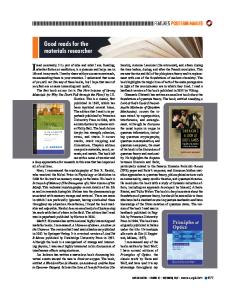Materials Researcher Switches from Brake Rotor Materials to Crash Dummies
- PDF / 74,121 Bytes
- 2 Pages / 612 x 792 pts (letter) Page_size
- 68 Downloads / 283 Views
Materials Researcher Switches from Brake Rotor Materials to Crash Dummies Alan Taub A little over two years ago, I moved from Ford’s Scientific Research Laboratory and joined Product Development as manager of the Vehicle Crash Safety Engineering Department. This new career focus has been accompanied by a number of changes. The most obvious has been with my family. For 20 years, I would go home and describe breakthroughs in superconducting magnets and brake rotor materials. However, this failed to impress my family. But when they found out that I worked with crash dummies, all of a sudden I had a job they could relate to. I have received similar reactions from friends. While I was seldom asked about progress in understanding fatigue of aluminum engine blocks, everyone wanted to know the latest crash ratings of the vehicles they wished to purchase. In my present position, I lead more than 200 engineers who design and verify the safety crash performance of our vehicles. The department’s engineering sections begin with simplified concept models that are used to establish a vehicle architecture capable of meeting the crash performance targets. The design becomes more detailed as the program proceeds, resulting in complete finite element models that are exercised to evaluate how the vehicle will perform in a crash. These sophisticated computer-aided engineering analyses allow us to simulate a number of different crash modes in great detail. Once the performance is optimized, vehicle prototypes are constructed and tested in many conMRS BULLETIN/JUNE 2000
Alan Taub works with crash dummies in his role as manager of the Vehicle Crash Safety Engineering Department at Ford.
figurations by impacting both barriers and other vehicles. On a typical vehicle program, several hundred crash simulations and more than 50 physical crashes are
performed. These tests employ highly complex instrumentation to fully characterize both the structural performance of the vehicle and the forces on the occupant 51
CAREER CLIPS
dummies. Extensive biomechanical research in the industrial, government, and academic laboratories has enabled us to relate the accelerations and deflections of the dummy to the damage limits of humans. The vehicle design is improved until the dummy performance during a crash meets and, in most cases, exceeds government regulations. In addition to regulatory compliance, Ford’s internal safety guidelines and due care requirements address crash performance in other situations that could be experienced in the real world. Our vehicles are released to the marketplace only after successful completion of these tests. I cannot say that when I entered graduate school in materials science, I was planning for this position. In fact, the first 20 years of my career followed the traditional path for industrial materials researchers. After completing my PhD program, I joined the Materials Properties and Processes Laboratory at General Electric’s Corporate Research and Development Center. There I performed research on amorphous metal
Data Loading...











